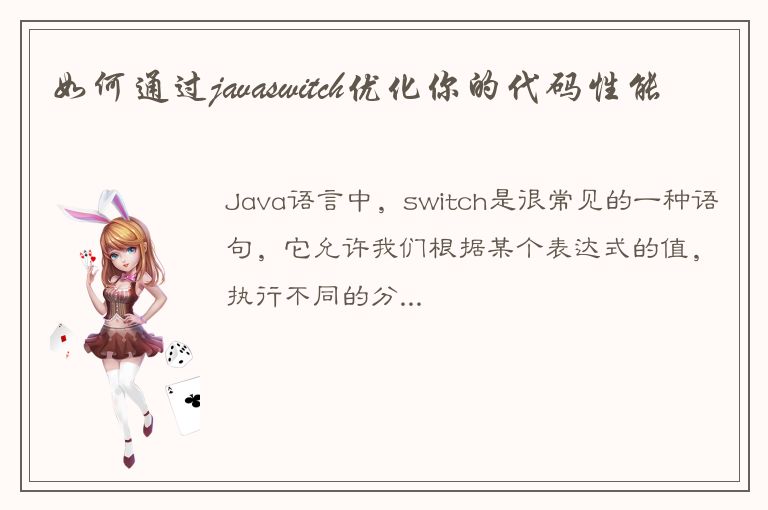Java语言中,switch是很常见的一种语句,它允许我们根据某个表达式的值,执行不同的分支。看起来很简单,但实际上,不合理的使用switch会影响代码的性能。
在本文中,我们将探讨如何通过合理使用switch语句来优化Java代码的性能。我们将从以下方面进行分析:

1. switch语句的语法和使用方法
2. switch语句和if-else语句的性能比较
3. 如何优化switch语句的性能
4. 使用Java 12中的新特性——switch表达式
1. switch语句的语法和使用方法
首先,我们来看一下switch语句的语法:
switch(expression){
case constant:
statement sequence
break;
case constant2:
statement sequence
break;
default:
statement sequence
}
- expression是一个声明或表达式。
- case是一个匹配值,如果expression满足该值,则执行随后的语句。
- 如果没有任何一个case匹配expression的值,则执行default后的语句。
- break语句用于跳出switch语句。
下面是一个使用switch语句的例子:
public class SwitchDemo {
public static void main(String[] args) {
int dayOfWeek = 5;
String day = "";
switch (dayOfWeek) {
case 1:
day = "Monday";
break;
case 2:
day = "Tuesday";
break;
case 3:
day = "Wednesday";
break;
case 4:
day = "Thursday";
break;
case 5:
day = "Friday";
break;
case 6:
day = "Saturday";
break;
case 7:
day = "Sunday";
break;
default:
throw new IllegalArgumentException("Invalid day of the week: " + dayOfWeek);
}
System.out.println("Today is " + day);
}
}
在上面的例子中,我们使用switch语句,根据dayOfWeek变量的值,选择不同的字符串。
2. switch语句和if-else语句的性能比较
在某些情况下,switch语句可能是我们代码中的瓶颈。例如,如果我们有1000个case语句,而我们选择第一个case语句,那么Java将不得不比较表达式和每个case语句直到找到匹配项。这可能非常耗费时间和资源。
相反,使用if-else语句可能更快。if-else语句是逐个比较条件,如果找到匹配项,则立即停止。
但是,我们必须明确一点,switch语句和if-else语句都可以用于不同的情况。因此,我们应该具体问题具体分析,选择最优的解决方案。
3. 如何优化switch语句的性能
如果我们决定使用switch语句,则有几种方法可以优化它的性能。
3.1. 优化case语句的顺序
尽可能将最有可能的case语句放在前面。这样,在运行时,我们有更大的概率找到匹配项。如果我们有1000个case语句,而我们最有可能选择1000个,那么第1000个case语句放在第一位将比反过来更快。
3.2. 使用枚举
如果我们有一个预定义的有限集,我们可以使用枚举类型而不是数字。这样可以使代码更加可读和易于维护。
3.3. 使用Switch-String
在Java 7中,引入了一种新的语法,可以使用字符串而不是数字或枚举类型。这种语法被称为Switch-String,可以包含在switch语句中,让我们的代码更加清晰易懂。
下面是一个使用Switch-String的示例:
public class SwitchStringDemo {
public static void main(String[] args) {
String fruit = "apple";
switch (fruit) {
case "apple":
System.out.println("This is an apple.");
break;
case "orange":
System.out.println("This is an orange.");
break;
case "banana":
System.out.println("This is a banana.");
break;
default:
System.out.println("I do not know what this is.");
}
}
}
3.4. 使用Hash表
如果我们有一些预定义值,并且这些值非常多,这时使用Switch语句或if-else语句将非常麻烦和低效。在这种情况下,我们可以使用Hashtable或HashMap等哈希表数据结构。哈希表是对存储键值对的数据结构进行快速查找的一种方法。
下面是一个使用HashMap的示例:
public class HashMapDemo {
public static void main(String[] args) {
Map
fruits.put("apple", "This is an apple.");
fruits.put("orange", "This is an orange.");
fruits.put("banana", "This is a banana.");
System.out.println(fruits.getOrDefault("papaya", "I do not know what this is."));
}
}
在上面的例子中,我们使用HashMap来存储预定义值,并使用getOrDefault方法在没有找到匹配项时返回默认值。
4. 使用Java 12中的新特性——switch表达式
Java 12中引入了一种新的语法,称为switch表达式。这种语法允许我们更简洁和优雅地编写switch语句。
下面是一个使用switch表达式的示例:
public class SwitchExpressionDemo {
public static void main(String[] args) {
String fruit = "apple";
String message = switch (fruit) {
case "apple" -> "This is an apple.";
case "orange" -> "This is an orange.";
case "banana" -> "This is a banana.";
default -> "I do not know what this is.";
};
System.out.println(message);
}
}
在上面的代码中,我们使用了Java 12中的新特性——switch表达式。与以前版本的Java中的switch语句相比,这个语法非常简洁,因为它将根据代码块中的case语句执行一个操作,并使用箭头运算符(->)返回一个值。
总结
Switch语句是一种可以使我们的代码更可读和易于维护的强大工具。但在使用Switch语句时,请始终记住,性能是重要的。借助优化方式和Java 12中添加的switch表达式,我们可以使switch语句更高效和简洁。




 QQ客服专员
QQ客服专员 电话客服专员
电话客服专员